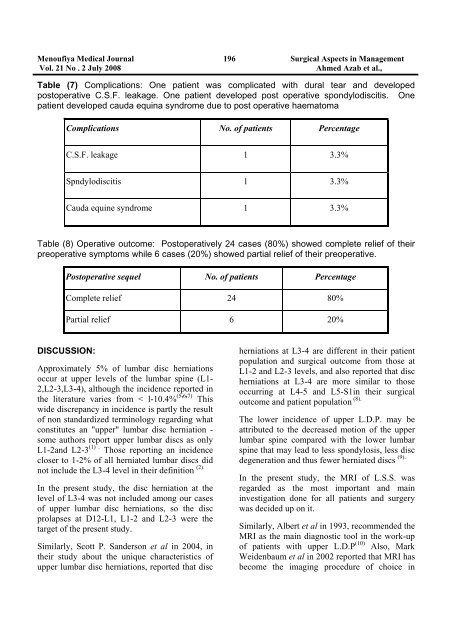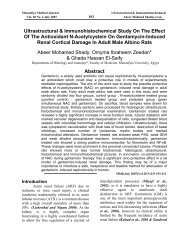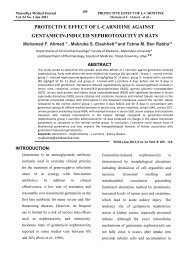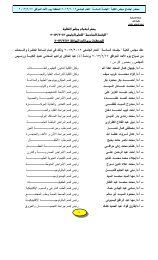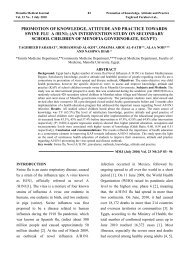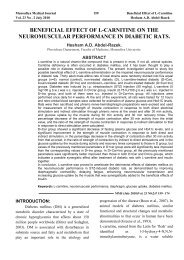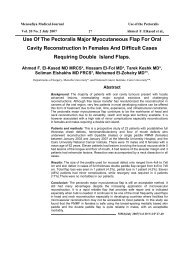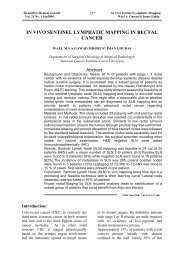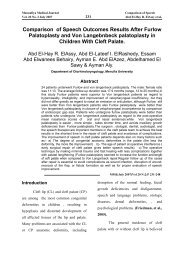Ahmed Azab *, Adel Hanafy *, Alaa Essa, Khaled Aref, Hesham ...
Ahmed Azab *, Adel Hanafy *, Alaa Essa, Khaled Aref, Hesham ...
Ahmed Azab *, Adel Hanafy *, Alaa Essa, Khaled Aref, Hesham ...
Create successful ePaper yourself
Turn your PDF publications into a flip-book with our unique Google optimized e-Paper software.
Menoufiya Medical Journal 196 Surgical Aspects in Management<br />
Vol. 21 No . 2 July 2008 <strong>Ahmed</strong> <strong>Azab</strong> et al.,<br />
Table (7) Complications: One patient was complicated with dural tear and developed<br />
postoperative C.S.F. leakage. One patient developed post operative spondylodiscitis. One<br />
patient developed cauda equina syndrome due to post operative haematoma<br />
Complications No. of patients Percentage<br />
C.S.F. leakage 1 3.3%<br />
Spndylodiscitis 1 3.3%<br />
Cauda equine syndrome 1 3.3%<br />
Table (8) Operative outcome: Postoperatively 24 cases (80%) showed complete relief of their<br />
preoperative symptoms while 6 cases (20%) showed partial relief of their preoperative.<br />
Postoperative sequel No. of patients Percentage<br />
Complete relief 24 80%<br />
Partial relief 6 20%<br />
DISCUSSION:<br />
Approximately 5% of lumbar disc herniations<br />
occur at upper levels of the lumbar spine (L1-<br />
2,L2-3,L3-4), although the incidence reported in<br />
the literature varies from < l-10.4% (5 ' 6 ' 7) This<br />
wide discrepancy in incidence is partly the result<br />
of non standardized terminology regarding what<br />
constitutes an "upper" lumbar disc herniation -<br />
some authors report upper lumbar discs as only<br />
L1-2and L2-3 (1) . Those reporting an incidence<br />
closer to 1-2% of all herniated lumbar discs did<br />
not include the L3-4 level in their definition (2).<br />
In the present study, the disc herniation at the<br />
level of L3-4 was not included among our cases<br />
of upper lumbar disc herniations, so the disc<br />
prolapses at D12-L1, L1-2 and L2-3 were the<br />
target of the present study.<br />
Similarly, Scott P. Sanderson et al in 2004, in<br />
their study about the unique characteristics of<br />
upper lumbar disc herniations, reported that disc<br />
herniations at L3-4 are different in their patient<br />
population and surgical outcome from those at<br />
L1-2 and L2-3 levels, and also reported that disc<br />
herniations at L3-4 are more similar to those<br />
occurring at L4-5 and L5-S1in their surgical<br />
outcome and patient population (8).<br />
The lower incidence of upper L.D.P. may be<br />
attributed to the decreased motion of the upper<br />
lumbar spine compared with the lower lumbar<br />
spine that may lead to less spondylosis, less disc<br />
degeneration and thus fewer herniated discs (9).<br />
In the present study, the MRI of L.S.S. was<br />
regarded as the most important and main<br />
investigation done for all patients and surgery<br />
was decided up on it.<br />
Similarly, Albert et al in 1993, recommended the<br />
MRI as the main diagnostic tool in the work-up<br />
of patients with upper L.D.P (10) Also, Mark<br />
Weidenbaum et al in 2002 reported that MRI has<br />
become the imaging procedure of choice in


